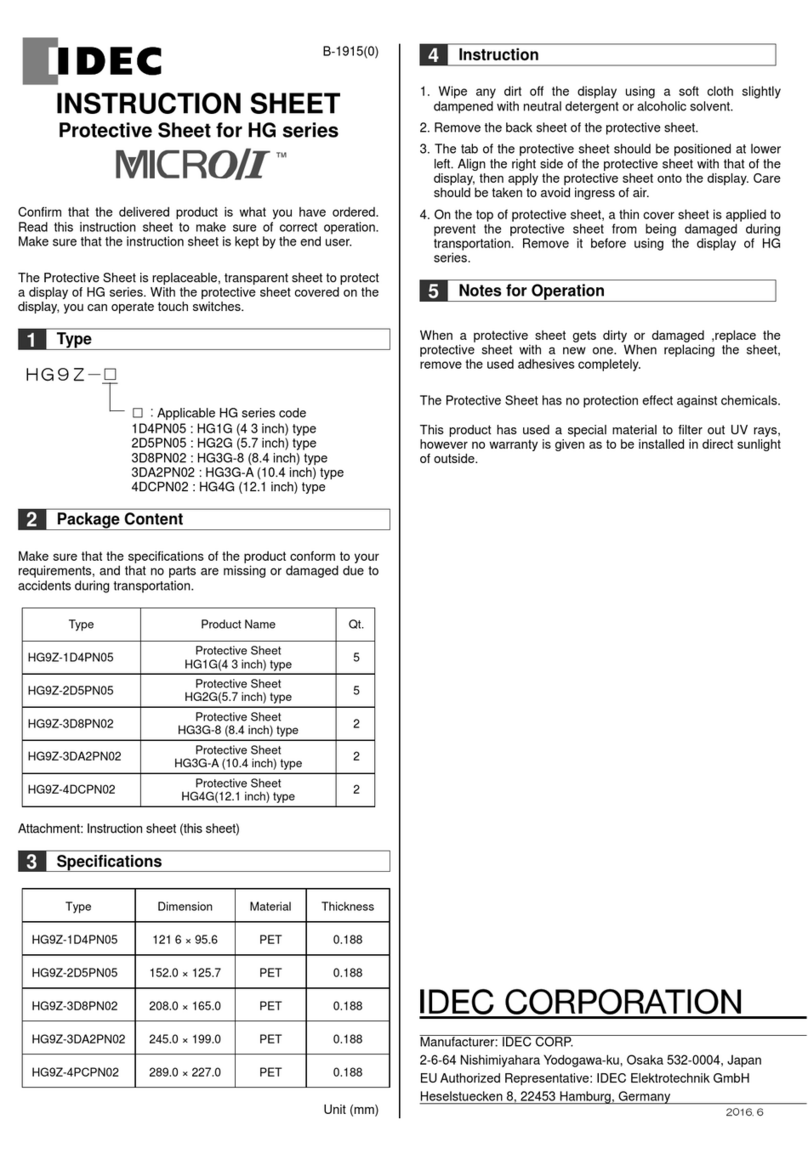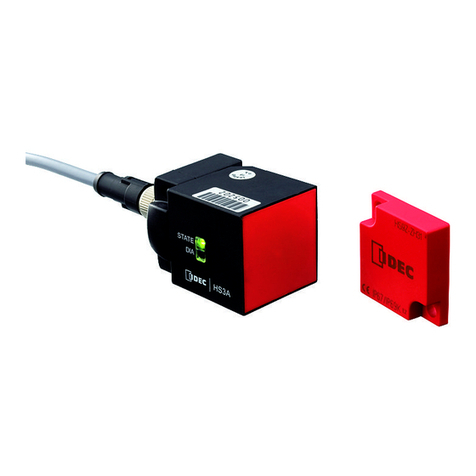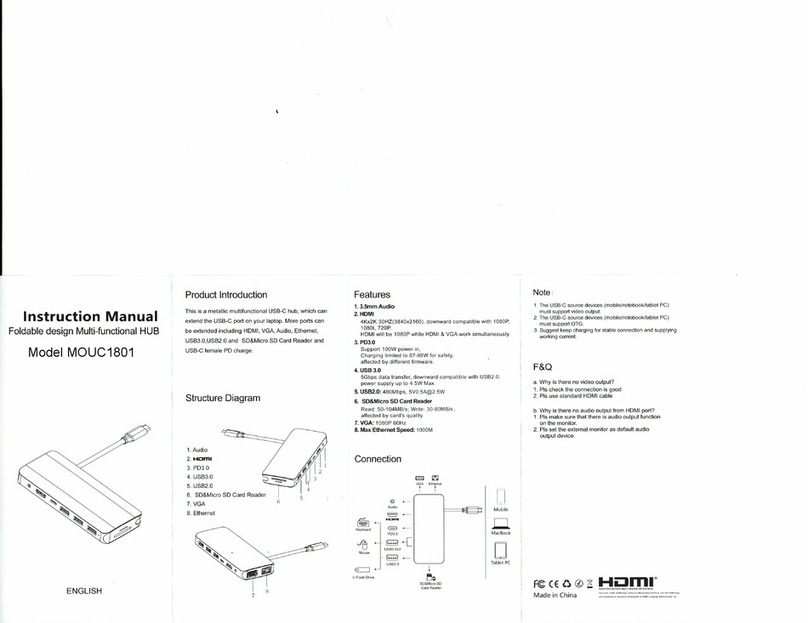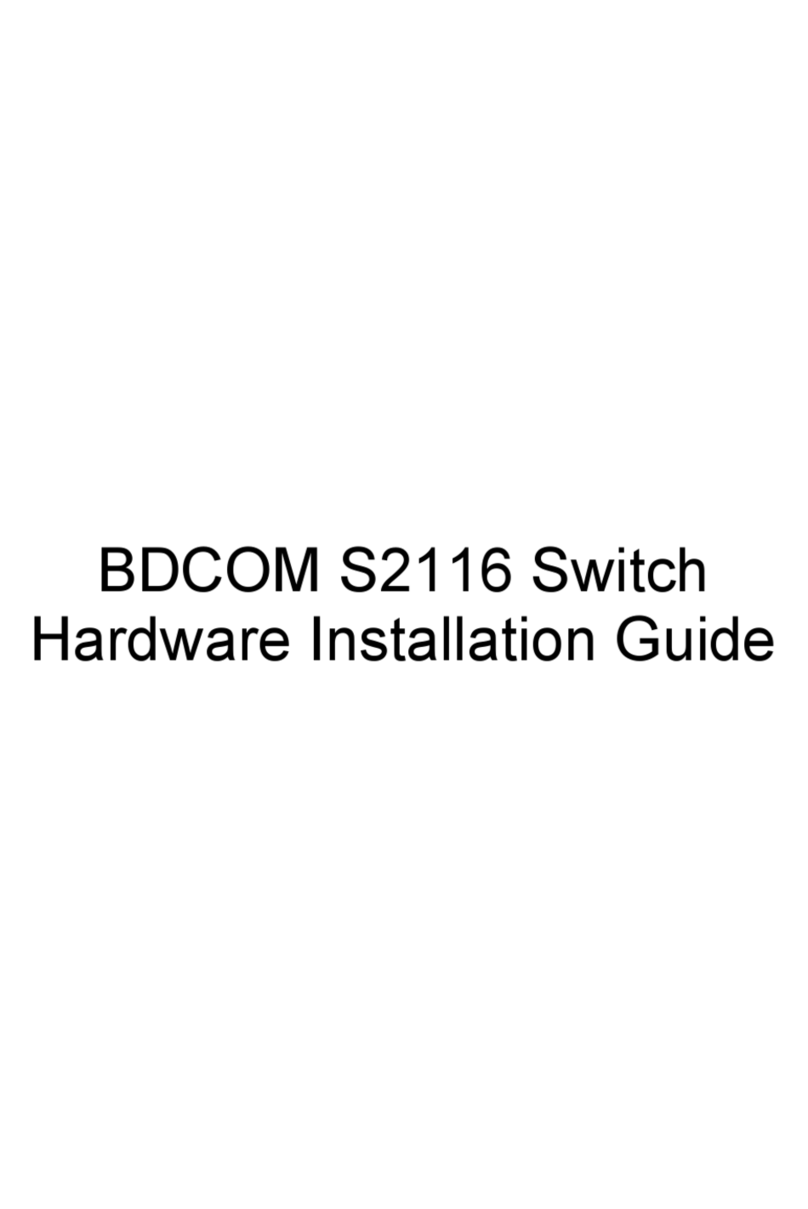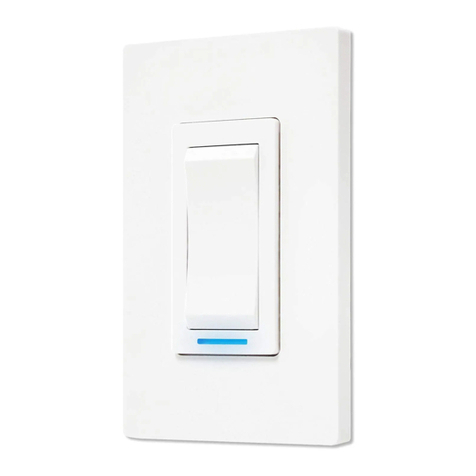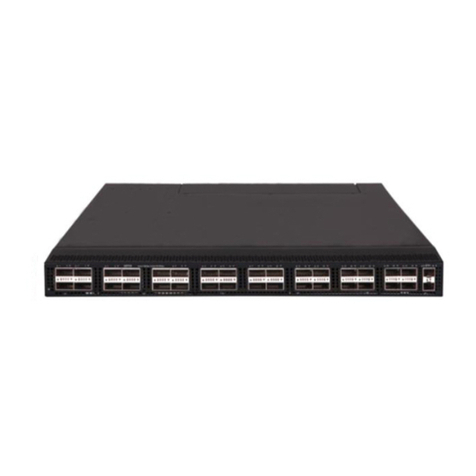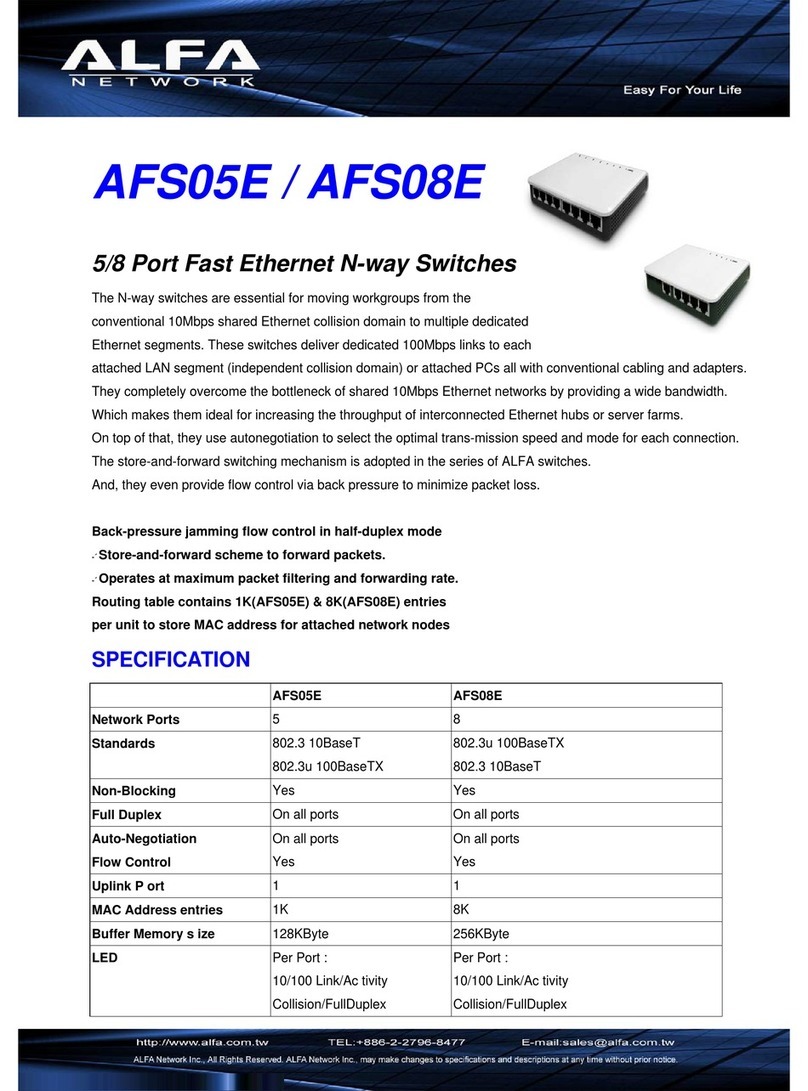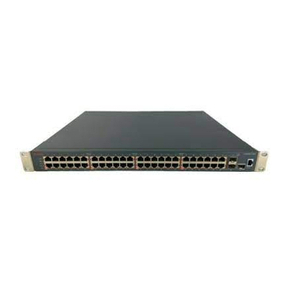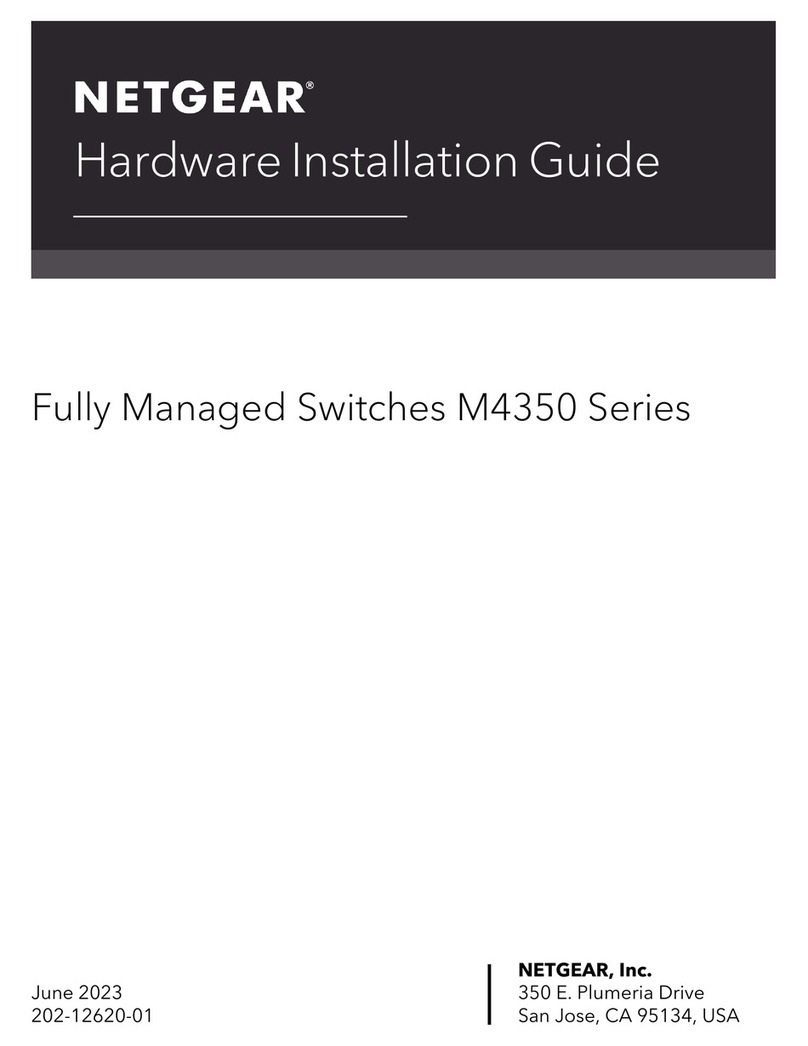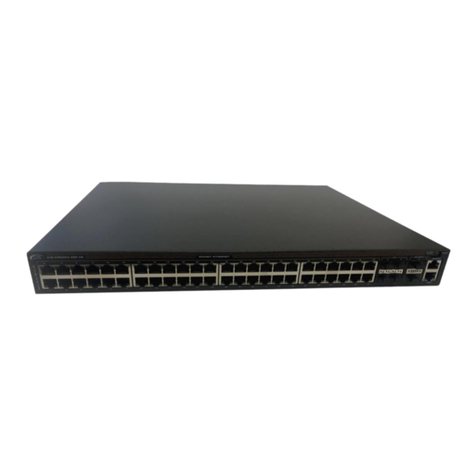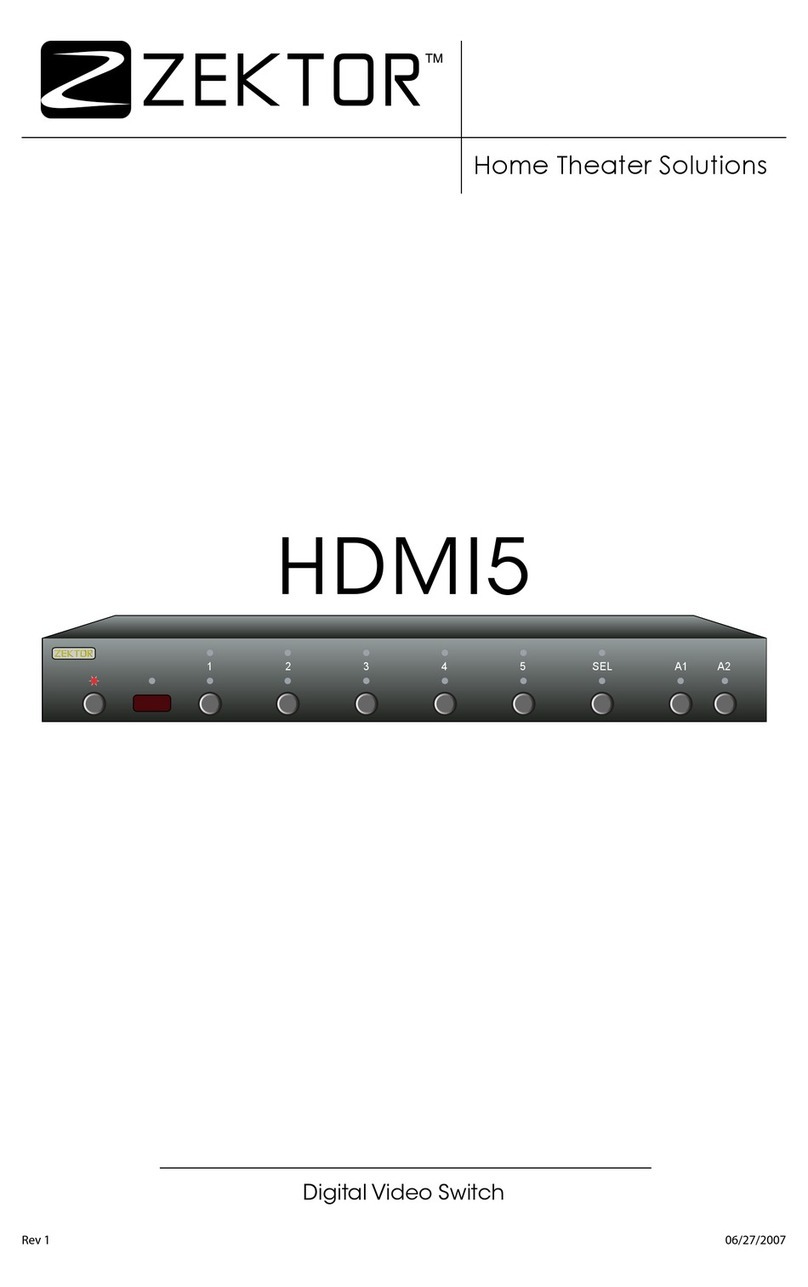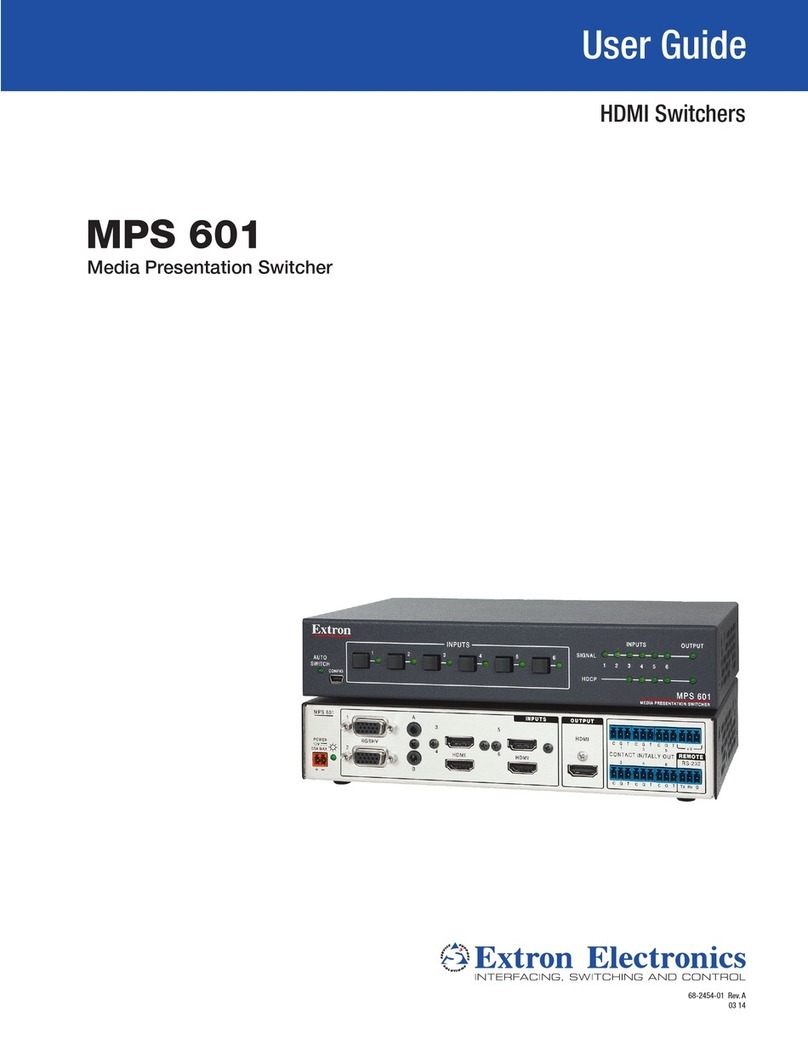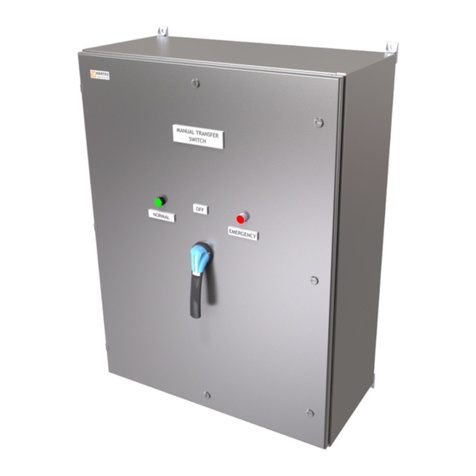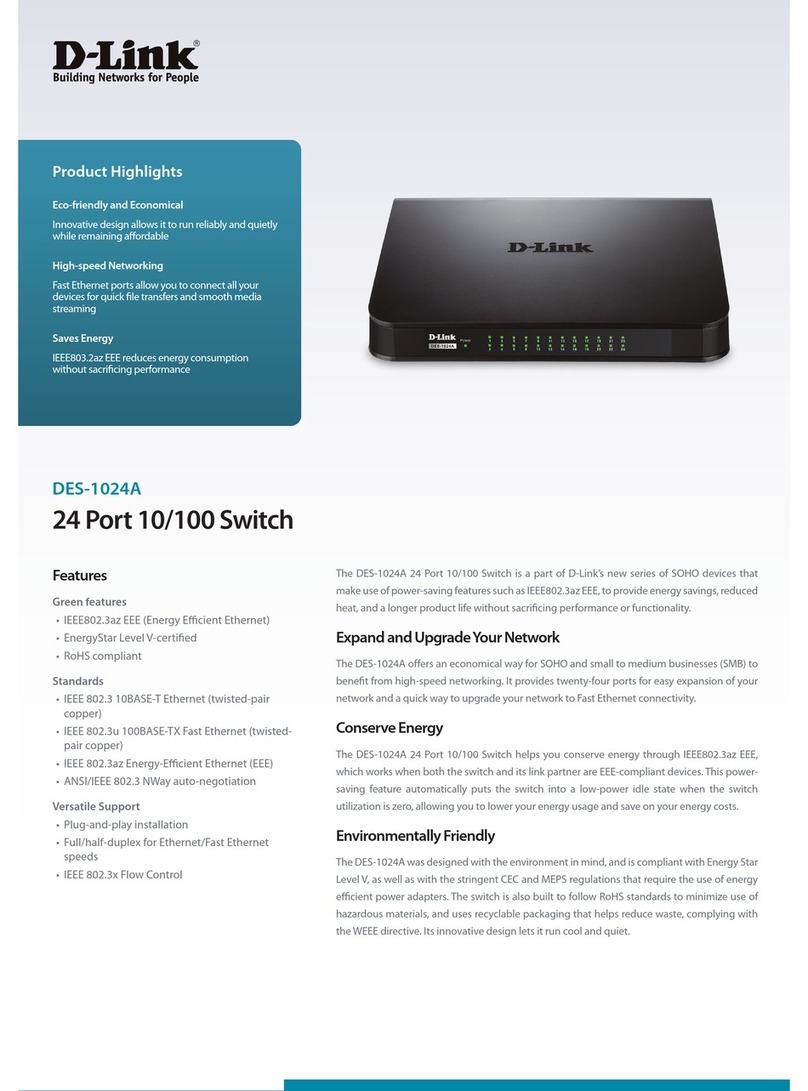IDEC HS1C Series User manual

B-1909-1(0)
INSTRUCTION SHEET - HS1C Series Solenoid Type Safety Switch 2016.08
2Specifications and Ratings
*2 Basic insulation of 4kV impulse withstand voltage is ensured between different
contact circuits and between contact circuits and LED or solenoid in the enclosure.
When both SELV (safety extra low voltage) or PELV (protective extra low voltage)
circuits and other circuits (such as 230V AC circuits) are used for the solenoid
power and contact circuits at the same time, the SELV or PELV requirements are
not met any more.
*3 The actuator locking strength is rated at 1,500N of static load. Do not apply a load
higher than the rated value. When a higher load is expected to work on the
actuator, provide an additional system consisting of another safety switch without
lock (such as the HS5D safety switch) or a sensor to detect door opening and stop
the machine.
*4 F1max. is maximum force. The actuator’s guard-locking force Fzh is calculated in
accodance with GS-ET-19 :
Ratings approved by safety agencies
1Type
*1 Type Nos. in [ ] are not supplied as
standard.Contact IDEC if required.
Main Circuit : 10A, Auxiliary Circuit : 3A
IEC60204-1/ EN60204-1
CSA C22.2 No.14, GB14048 5
GS-ET-19, UL508
IEC60947-5-1, EN60947-5-1
EN ISO / ISO14119
IP67 (IEC60529)
100 mΩ maximum (Ini ial value)
20 N minimum
11 mm minimum
0.05 to 1.0 m/s
900 operations/hour
Actuator Tensile Strength
when Locked
Operating Speed
Operating Frequency
‹Ue , Ie›
(Reference Values)
Contact Ra ings
Thermal Current ‹Ith›
Applicable Directives
Applicable Standards
AC DC AC DC
Standards for Use
Degree of Protection
Contact Resistance
Direct Opening Force
Direct Opening Travel
Main
Circuit
Auxiliary
Circuit
Induc ive load(DC-13)
Resistive load(DC-12)
Induc ive load(AC-15)
Resistive load(AC-12)
Induc ive load(DC-13)
Resistive load(DC-12)
Induc ive load(AC-15)
Resistive load(AC-12)
30V 125V 250V
10A 10A 6A
10A 5A 3A
6A - -
3A 0.9A -
- 3A 3A
- - 3A
3A - -
3A 0.9A -
Low Voltage Direc ive, Machinery Directive
Operating Condition Operating Temperature
Operating Humidity
Pollution Degree
Al itude
-25 to +50°C (no freezing)
45 to 85%RH (no condensation)
3
2,000m maximum
300V (Between ground and LED, solenoid circuit : 60V)
4kV (Between ground and LED, solenoid circuit : 2.5kV)
Raed Insulation voltage ‹Ui›
Inpulse withstand voltage ‹Uimp›
Class of Protection
Class
I
( EC61140) *2
B10d
2,000,000 (EN ISO 13849-1 Annex C Table C.1)
Shock Resistance
Vibration Resistance Operating Extremes :10 to 55Hz, half amplitude 0.5mm
Damage Limits : 30Hz, half amplitude 1.5mm
Fzh=1,500N minimum
F1max.=1,950N minimum (GS-ET-19) *3, *4
Damage Limits : 1,000m/s2
Mechanical Durability 1,000,000 operations min. (GS-ET-19)
Electrical Durability
(900 operations / hour)
1,000,000 operations min. (AC/DC 24V 100mA)
100,000 opera ions min. (AC-12 250V•6A)
(Examples of Mounting on Hinged Doors)(Examples of Mounting on Sliding Doors)
3Mounting Examples
• Install the interlock switch on the immovable machine or guard, and install the
actuator on the movable door. Do not install both interlock switch and actuator on
themovable door, otherwise he angle of insertion of the actuator to he safety switch
may become inappropriate, and failure will occur.
Hinged
Door
HS9Z-A2
Actuator
Safety
Switch
Door
Safety
Switch
HS9Z-A1
Actuator
Lock
Door Stop Latch
HS9Z-A1
Actuator
When the center of the hinged door is on
the extension line of the contact surface
of actuator and safety switch.
When he center of the hinged door is on
the extension line of he actuator
mounting surfase.
When using the safety switch for a hinged door, the minimum radius of the applicable
door is shown in the following figures.
Minimum Radius of Hinged Door
Door Hinge
Minimum Radius
230mm
Door Hinge
Minimum Radius
130mm
Minimum Radius
400mm
Minimum Radius
240mm
Door Hinge Door Hinge
R(Red), G(Green) (Φ12Lens)
LED lamp
10mA
24VDC
Approx. 10W
Rated Voltage × 10% minimum (at 20°C)
Rated Voltage × 85% maximum (at 20°C)
415mA
24VDC
250V AC,10A fast acting type fuse
Short-Circuit Protective Device
g
Cont ct Resistance
Conditional short circuit current 100A(250V)
Illumination Color
Light Source
Rated Current
Rated Operating Voltage
Rated Power Consumption
Turn OFF Voltage
Turn ON Voltage
Rated Current
Rated Operating Voltage
Solenoid
Indicator
CAUTION
The figures shown above are based on the condition that the actuator enters and
exits the actuator entry slot smoothry when the door is closed or opened. Since
there may be deviation or dislocation of the hinged door, make sure of correct
operation in the actual application before installation.
Door Hinge
Minimum
Radius
50mm
Door Hinge
Minimum
Radius
80mm
• L-shaped actuator : HS9Z-A2
• Adjustable actuator : HS9Z-A3
Thank you for purchasing this IDEC product. Confirm that the delivered product is
what you have ordered. Read this instruction sheet to make sure of correct operation.
In this operation instruction sheet, safety precautions are categorized in order of
importance to Warning and Caution :
Warning notices are used to emphasize that improper operation may cause severe
personal injury or death.
Caution notices are used where inattention might cause personal injury or damage to
equipment.
INSTRUCTION SHEET
Original Instructions
Solenoid Type Safety Switch
HS1C Series
SAFETY PRECAUTIONS
CAUTION
WARNING
Fzh
=
maximum force (F1max.)
Safety coefficient (=1.3)
Circuit Diagram No.
Main Circuit Auxiliary Circuit
blank : 1NC+1NC 1NO/1NO
1 : 1NC+1NC 1NO
2 : 1NC+1NC 1NC+1NC
3 : 1NC+1NC 1NC
Solenoid voltage
4 : DC24V
LED voltage
4 : DC24V
[ 0 ] : Without LED
Solenoid unit mounting position
R : Right side
[ L ] : Left side Housing Color
R : Red
Indicator Color
G : Green
R : Red
HS1C-R144R-R
(1) TÜV rating
AC-15 250V, 3A
(3) CCC rating
AC-15 250V, 3A
DC-13 125V, 0.9A
(2) UL, c-UL rating
3A, 250V ac, General Use
3A, 30V dc, Resistive

B-1909-1(0)
INSTRUCTION SHEET - HS1C Series Solenoid Type Safety Switch
( 2 / 5 )
2016.08
Center Safety Switch
±1.0 mm±1.0 mm
• Mounting tolerance of the actuator is 1.0mm from
the center of the actuator to up, down, right, and,
left.
• Make sure the actuator can be inserted into the
entry slot without any issue.
Actuator Mounting Tolerance
Recommended Screw Tightening Torque
For mounting the safety switch (M5 hexagon socket head cap screw) *6
For moun ing the actuator
(M6 hexagon socket head cap screw)
*6
For moun ing the lid (M4)
Connector (G1/2)
Plug for Unused Conduit Hole (G1/2)
Screw Terminal No.1 to 6 (M3)
Screw Terminal No.7,8 (M3.5)
Ground Terminal screw (M4)
Angle adjusting screw of HS9Z-A3
(M3 hexagon socket head cap screw)
Screw Tightening Torque
Name or Use
CAUTION
*6 When the torque is not enough to recommended screw tightening torque, make
sure that the screw do not become loose by using adhesive sealants etc. to
keep right opera ion and mounting positioning.
• The HS1C allows manual unlocking of the actuator to
precheck door operation before wiring or turning on power, as
well as for emergency use such as a power failure.
• Remove the screw from the side of the safety switch using the
wrench for mounting the lid. Push the lever inside the safety
switch towards the pilot light using a small screwdriver until the
actuator is unlocked. See the figure on the right.
Manual Unlocking
Screwdriver
4.5~5.5 N•m
4.5~5.5 N•m
1.1~1.3 N•m
2.7~3.3 N•m
1.8~2.2 N•m
0.4~0.6 N•m
0.9~1.1 N•m
0.9~1.1 N•m
0 8 N•m
• As shown below, the mounting reference position of the actuator inserted into the
safety switch is the actuator cover or stop film touches the safety switch ligh ly. (After
mounting the actuator, remove the actuator cover or stop film from the safety switch.)
Actuator Mounting Reference Position
HS9Z-A2
Actuator
HS9Z-A1
Actuator
Actuator
Cover
Safety
Switch
Door Stop
Door Stop
Actuator
Cover
Safety Switch
HS9Z-A3
Actuator
Stop film
Safety Switch
Note : During installation, ensure that there is no excess force applied between the
safety switch and actuator by installing a door stopper as shown in the image.
• Actuator can move 3.8mm (HS9Z-A1 and -A2) /
2.7mm (HS9Z-A3) from the mounting position
without affecting the contact operation.
• When closing the door (when actuator is
inserted into safety switch), the solenoid is
locked as the actuator has reached at approx.
6.4mm (HS9Z-A1 and -A2) / 5.3mm (HS9Z-A3)
to the moun ing reference position.
Devia ion of
actuator position Deviation of
door position ≤ 3.8 / 2.7mm+
*5 To ensure that the door locks correctly, install the actuator in a position that is
within 6.4 mm (HS9Z-A1 and -A2) / 5.3 mm (HS9Z-A3) of the standard
installation position. If the actuator is not in the correct position, the door will not
lock and there is a risk that an incorrect safety circuit may turn ON.
3.8mm 2.7mm
HS9Z-A1
and -A2 HS9Z-A3
*5 *5
Approx.
6.4mm
Approx.
5.3mm
HS9Z-A1
and -A2 HS9Z-A3
CAUTION
• Using the angle adjusting screw (M3 hexagon
socket head screw), the actuator angle can be
adjusted up to 20°.
• The larger the actuator angle, the smaller the appli-
cable radius of the door swing. After installing the
actuator, open the door. Then adjust the actuator
angle so that the actuator enters the entry slot of
the safety switch properly.
• After adjusting the actuator angle, apply loctite or the like on the adjusting screw to
prevent loosening.
Adjusting the Angle Adjustable Actuator (HS9Z-A3)
20°
Angle adjusting
screw
Installation
• Do not apply an excessive shock to the safety switch when
opening or closing the door. A shock to the safety switch
exceeding 1,000 m/s2may cause failure.
• Provide a door guide, and ensure that force is applied on the
safety switch only in the actuator insertion direction.
• Do not pull the actuator while it is locked. Also, regardless of
door types, do not use the safety switch as a door lock. Install
a separate lock as shown in item 3.
• When opening the safety switch lid to wire, open the lid 1 only.
(See the figure on the right.)Never remove other screws,
otherwise the safety switch may be damaged.
• The safety switch cover can be only removed or installed with
the special L-shaped key wrench supplied with the switch.
• Make sure to install the product in a place where it cannot be
damaged. Make sure to conduct a proper risk assessment
evaluation before using the product, and use a shield or a
cover to protect the product if need be.
• Solenoid has polarity. Be sure to wire correctly. Do not apply
voltage that exceed the rated voltage, otherwise the solenoid
will be burnt out.
• Avoid foreign objects such as dust, liquid, and oil from entering
the switch while connecting a conduit or wiring.
• Entry of foreign objects in the actuator entry slot may affect the mechanism of the
switch and cause a breakdown. If the operating atmosphere is contaminated, use a
protective cover to prevent the entry of foreign objects into the switch through the
actuator entry slots.
• Use only the designated actuator for the HS1C. Other actuators will cause a break-
down of the switch.
4Precautions for Operation
1
Screw for manual
unlocking
Two actuator
entry slot
L-shaped wrench
attached to he
safety switch
Type: HS9Z-T1
WARNING
• Turn off the power to the safety switch before starting installation, removal, wiring,
maintenance, and inspection on the safety switch. Failure to turn power off may
cause electrical shocks or fire hazard.
• Use wires of a proper size to meet voltage and current requirements. Tighten the
terminal screws to a recommended tightening torque of 1.0N・m. Loose terminal
screws will cause unexpected heating and fire hazard during operation.
CAUTION
• Before manually unlocking the safety switch, make sure the machine has come to
a complete stop. Manual unlocking during operation may unlock the switch before
the machine stops, and the function of safety switch with solenoid is lost.
• After the unlocking operation, be sure to turn the screw to the original position for
safety.
CAUTION
• Regardress of door types, do not use the safety switch as a door stop. Install a
mechanical door stop at the end of the door to protect the safety switch against an
excessive force.
• Mount the actuator so that it will not hit the operator when the door is open,
o herwise injury may be caused.
• Pay attention to the management of spare actuator. Safety function of door inter-
lock switch will be lost in case the spare actuator is inserted into the interlock
switch. Ensure that the actuator is firmly fastened to the door (welding, rivet,
special screw) in the appropriate location, so that the actuator cannot be removed
easily.
• Do not cut or remodel the actuator, otherwise failure will occur.
• If multiple safety components are wired in series, the Performance Level to
ISO13849-1 will be reduced due to the restricted error detection under certain
circumstance.
• The insulation of the cable has to withstand environmental influences.
• The entire concept of the control system, in which the safety component is
integrated, must be validated to ISO13849-2.

B-1909-1(0)
INSTRUCTION SHEET - HS1C Series Solenoid Type Safety Switch
( 3 / 5 )
2016.08
5Contact Operation
Operation Cycle
Type
HS1C-□44R-□
Type
HS1C-□144R-□
Type
HS1C-□244R-□
Type
HS1C-□344R-□
3-4: Closed
1-2 : Open
5-6 : Off
3-4 : Closed
1-2 : Open
5-6 : Off
3-4 : Closed
1-2 : Closed
5-6 : Off
3-4 : Closed
1-2 : Closed
5-6 : Off
3-4 : Open
1-2 : Closed
5-6 : Off
3-4 : Open
1-2 : Closed
5-6 : Off
3-4 : Open
1-2 : Open
5-6 : Off
3-4 : Open
1-2 : Open
5-6 : Off
3-4 : Open
1-2 : Closed
5-6 : On
3-4 : Open
1-2 : Open
5-6 : On
3-4 : Open
1-2 : Open
5-6 : On
3-4 : Open
1-2 : Closed
5-6 : On
Main Circuit
Auxiliary Circuit
Solenoid Power
Main Circuit
Auxiliary Circuit
Solenoid Power
Main Circuit
Auxiliary Circuit
Solenoid Power
Main Circuit
Auxiliary Circuit
Solenoid Power
Closed Closed Open
• The machine can
be operated.
•Door is locked.
• The machine can
not be operated.
• Door is unlocked.
• The machine can
not be operated.
6Wiring
Wire Length inside the Safety Switch
Recommended Wire Core Size
Screw Terminal No.1, 2, 5, 6, 7, 8 : 0.5 to 0.75 mm
2
Screw Terminal No 3, 4, E : 1.0 to 1.25 mm
2
Safety Switch Connector
L1L2
Screw
Terminal
No.
Wire Stripping
Leng h : L2 (mm)
Wire Length :
L1(mm)
7±1
Through Conduit Hole
70±2
65±2
60±2
55±2
50±2
45±2
110±2
35±2
45±2
30±2
30±2
25±2
25±2
30±2
30±2
65±2
65±2
85±2
45±2
50±2
55±2
60±2
65±2
70±2
35±2
110±2
45±2
1
2
3
4
5
6
7
8
E
1 2 3
Applicable Crimping Terminal
Screw Terminal No. 1 to 6 : Direct Wiring Using a solid or standed wire
Note :When using a stranded wire, make sure that adjoining terminals are not
short-circuited with protruding core wires. Also, do not solder the core wires to
avoid protruding wires.
<Ferrules> : Recommended ferrules (Phoenix Contact)
Crimping Tool : CRIMPFOX UD6
Applicable Wire
0.5 to 0.75mm2
0.75 to 1.0mm2
1.0 to 1.5mm2
Type No.
AI 0.75-8 GY
AI 1.0-8 RD
AI 1.5-8 BK
Screw Terminal No. 7,8:
Terminal Screw (M3.5)
Screw Terminal No. E:
Ground Terminal Screw (M4)
3.8mm max.
7.6max.
3.5mm max.3.6mm min.
L1
Φ3.6mm min.
6.9max.
L1
Φ4.1mm min.
3.5mm min.
Note :Make sure to use an insulation tube
on the crimping terminal.
Insulation Tube
Wire
Crimping Terminal
Approx. 4mm
9mm max.
Conduit Thread
30mm max.
Applicable Connectors
Use a connector with a degree of protection IP67.
• When using flexible conduit and metal connector
Applicable Flexible Conduit Example
: Type VF-03 (made by Nihon Flex)
Applicable Metal Connector Example (G1/2)
: Type RLC-103 (made by Nihon Flex)
• When using plastic connector, metal connector and multi-core cable
(G1/2)
Applicable Plastic Connector Example : Type SCS-10□(made by Seiwa Electric)
Applicable Metal Connector Example : Type ALS-16□□ (made by Nihon Frex)
Note : Confirm the outside diameter of the multi-core cable, the connector type
depends on the outside diameter of multi-core cable.
1
21
2
1
43
3 4
43
(
-
)(+)
5 6
HS1C-R44R-□
HS1C-R144R-□
HS1C-R244R-□
Main Circuit :
Monitor Circuit :
Monitor Circuit :
Main Circuit :
Main Circuit :
Main Circuit :
1
2
(+)
7
(
-
)
8
1 2
43
HS1C-R344R-□Main Circuit :
Monitor Circuit :
CAUTION
*7 The Actuator is inserted , and HS1C is locked.
Contact Configuration
Contact Configuration*7
Type
Door monitor Lock monitorIndicator

B-1909-1(0)
INSTRUCTION SHEET - HS1C Series Solenoid Type Safety Switch
( 4 / 5 )
2016.08
7Example of wiring Diagram realizing Safety Category
Example of a circuit diagram for Safety Category 4
(attainable PL = e)
Example of a circuit diagram for Safety Category 3
(attainable PL = d)
(Condition 1: To apply the fault exclusion of mechanical structural parts including the actuator
→ Make sure to use the product within he product specification range described in his
manual and the version of the manual provided wi h the product.)
(Condition 2: Documentation of the reason for the machine/equipment manufacturer to have
applied the fault exclusion based on ISO13849-1, ISO13849-2 or IEC62061.)
S1: HS1C-24 Safety Switch with Solenoid
S2: Starting Switch (HW Series Momentary)
S3: Unlocking Enabling Switch
S4: Safety limit Switch
ESC: Outside start condition
K3, 4: Safety Contactor
F1: Outside fuse of safety relay module at power supply line
Note: Use the monitoring device(Safety relay module) provided the capavility to
detect a cross short circuit. The insulation of the cable has to withstand
environmental influences. If a control device other than the one shown in the
draft is used, the used control device has to be equipped with a cross short
circuit monitor.
L1(+)
DC24V
S3
F1
Output Circuit
K4
K3
HS1C-24
Safety Switch with Solenoid
HS9Z-A1 Actuator
N(-)
DC0V
A1(-)
A2(+)
S1
2
1
HR1S-AF Safety relay module
13
14
ESC
K4
K3
S2
4
3
Guard Open
S33 S34 13 23A1
S11 S22 14 24
A2 S12 S21
One of the example of
the circuit ; Safety
relay module, HR1S-AF
series manufactured
by IDEC CORPORATION
L1(+)
DC24V
S3
F1
Output Circuit
K4
K3
N(-)
DC0V
A1(−)
S1
13
14
ESC
K4
K3
S2
S4
1
2
Guard Open
HS1C-24
Safety Switch with Solenoid
HS9Z-A1 Actuator
HR1S-AF Safety relay module
S33 S34 13 23A1
S11 S22 14 24
A2 S12 S21
A2(+)
2
1
4
3
One of the example of
the circuit ; Safety
relay module, HR1S-AF
series manufactured
by DEC CORPORATION

B-1909-1(0)
INSTRUCTION SHEET - HS1C Series Solenoid Type Safety Switch
( 5 / 5 )
2016.08
Accessories dimensions
http://www.idec.com
Manufacturer: IDEC CORP.
2-6-64 Nishimiyahara Yodogawa-ku, Osaka 532-0004, Japan
EU Authorized Representative:IDEC Elektrotechnik GmbH
Heselstuecken 8, D-22453 Hamburg, Germany
DECLARATION OF CONFORMITY
We, DEC CORPORATION 2-6-64, Nishimiyahara Yodogawa-ku,Osaka 532-0004, Japan declare
under our sole responsibility that the product:
Description: Safety Switch
Model No: HS1C
to which this declaration relates is in conformity with the EC Directive on the following standard(s)
or other normative document(s). In case of alteration of the product, not agreed upon by us, this
declaration will lose its validity.
Applicable EC Directive : Low Voltage Directive (2014/35/EU)
Machinery Directive (2006/42/EC)
Applicable Standard(s) : EN 60947-5-1,GS-ET-19
Slot Plug
Note : Use the slot plug attached to the safety switch
to close the unused actuator entry slot.
8Dimensions (mm)
Safety Switch dimensions
Type : HS1C-R□44R-□
Type : HS1C-L□44R-□
Type : HS9Z-A1
2-M6
Mounting Hole Layout
Actuator cover
(supplied)
9Precaution for Disposal
Dispose of the HS1C safety switch as an industrial waste.
Type : HS9Z-A3
Type : HS9Z-A2
2-M6
Stopper
film
Angle ajsting screw
(M3 hexagon socket set screw)
Actuator cover
(supplied)
Actuator cover
(supplied)
(Supplied)
Main body mounting hole layout
4-M5
Main body mounting hole layout
42 47
23.5 26
68.8
to 72.6
42
1251.5
2
74
106
22
40
23.5
49.5
47
10
26
36.5
9
54.3
to 58.1
6 5±1
39.7
35
4
8.5±1
61 to 64.8
22
40 17.5±1
46.5 to 50.3
4.5
19.5±1
HS9Z-A1 Actuator
Two actuator mounting holes
(M6 hexagon socket head
cap screws)
20
2
90°
(41.5)
39.5 2
5.5
11.5
40
29.2
42.7
4.1
4-R3.2
2-R2
22
11 7.4
18
20
30
5
20°
2
72
58
58
1
12.3
MAX.33
44.4
R3.2
22
2-M6
7.4
22
(58.3) 2
19.3 5.5
9
40
2
4.1
22
29.2
42.7
47 3
4-R3.2
2-R2
Mounting Hole Layout
Mounting Hole Layout
Four Safety Switch mounting holes
(M5 hexagon socket head
cap screws)
HS9Z-A2
Actuator
4-M5
4247
23.5 26
This manual suits for next models
1
Table of contents
Other IDEC Switch manuals

IDEC
IDEC SX5E Series User manual
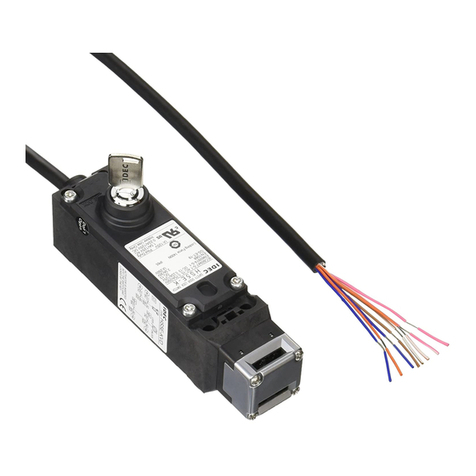
IDEC
IDEC HS5E-K User manual
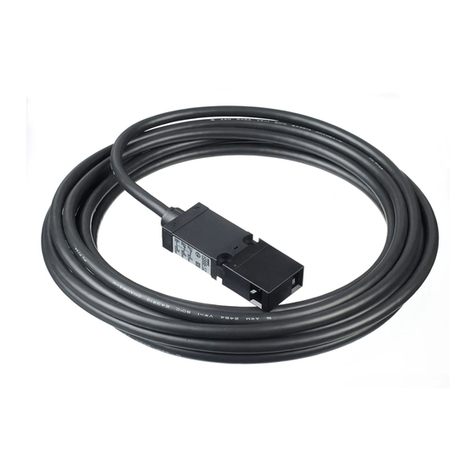
IDEC
IDEC HS6B Series User manual
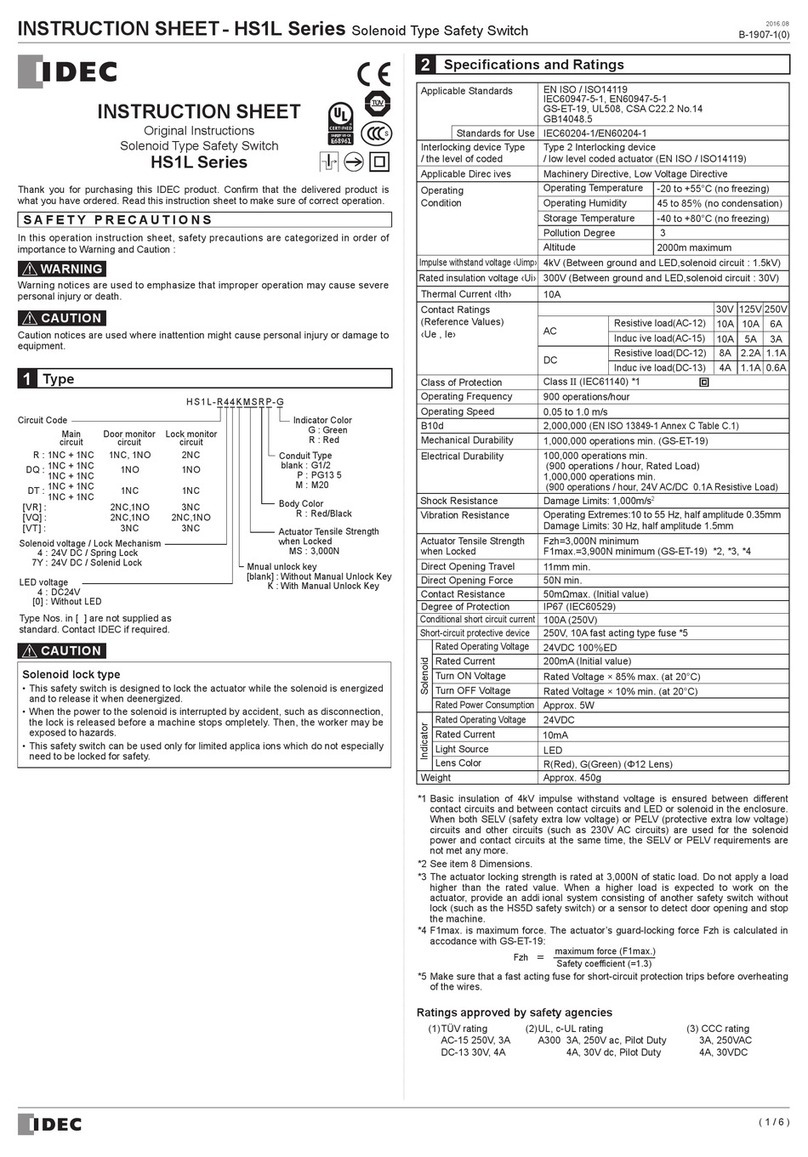
IDEC
IDEC HS1L Series User manual
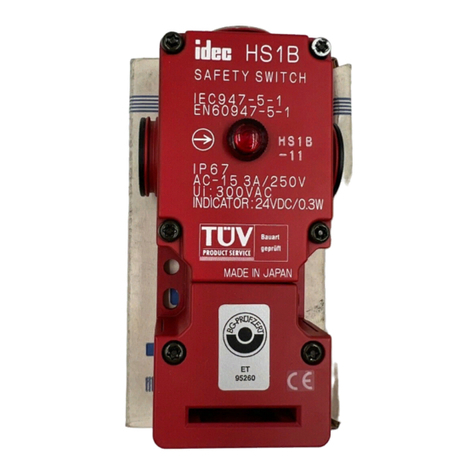
IDEC
IDEC HS1C Series User manual

IDEC
IDEC HS1E Series User manual
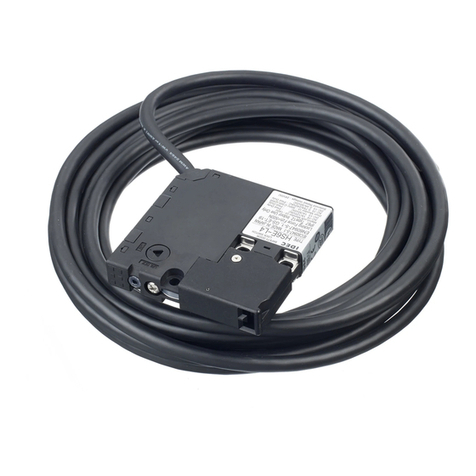
IDEC
IDEC HS6E Series User manual
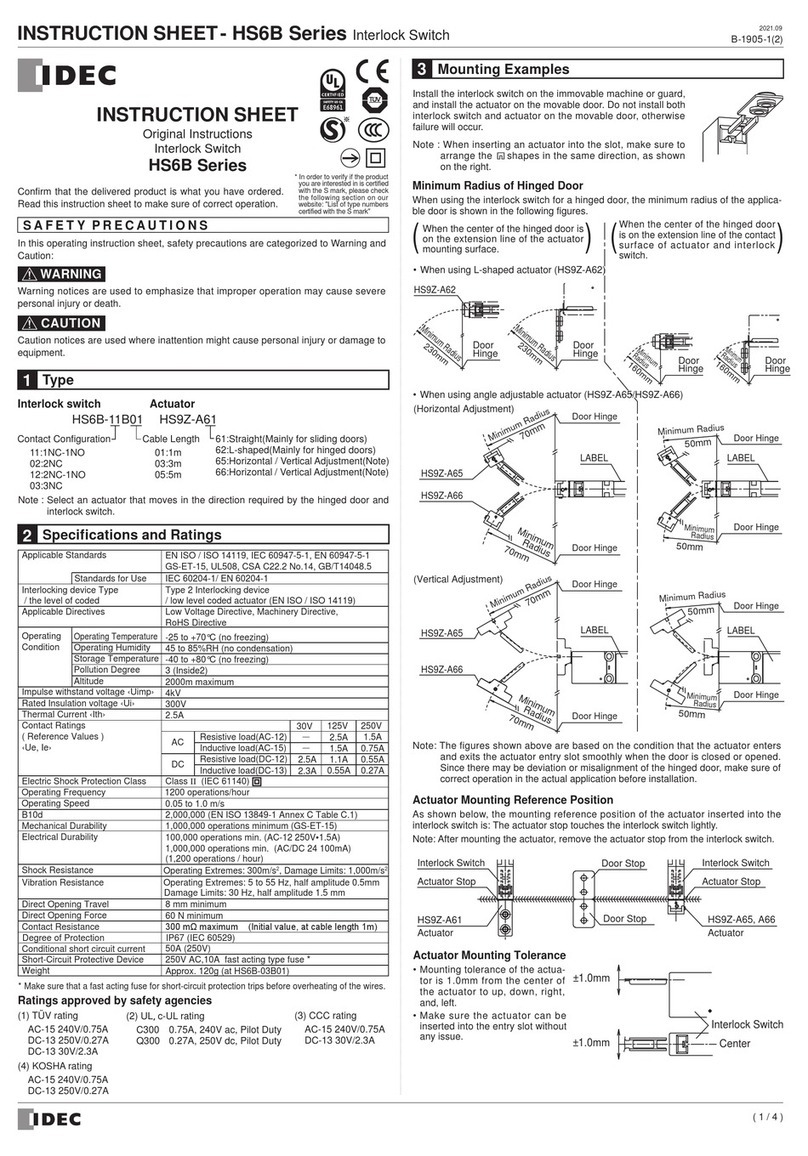
IDEC
IDEC HS6B Series User manual
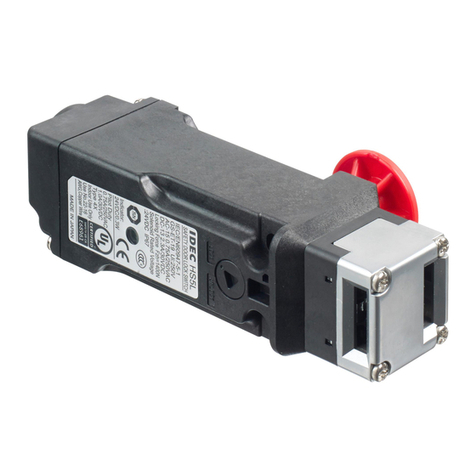
IDEC
IDEC HS5L Series User manual

IDEC
IDEC SA1U Series User manual
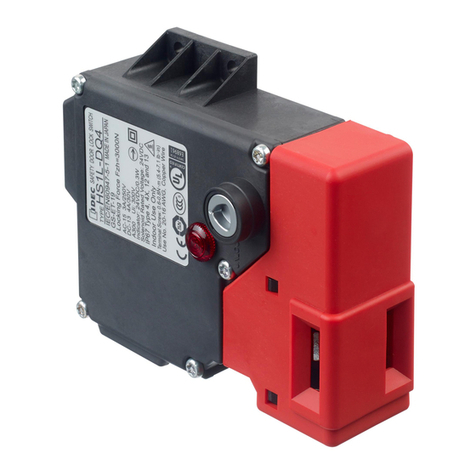
IDEC
IDEC HS1L Series User manual
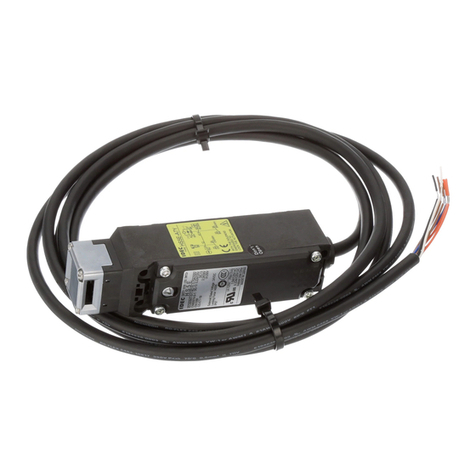
IDEC
IDEC HS5E Series User manual
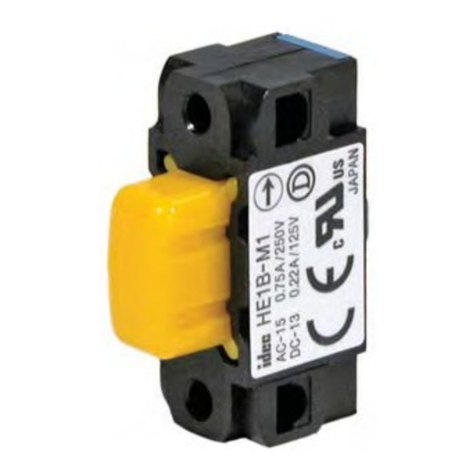
IDEC
IDEC HE1B Series User manual
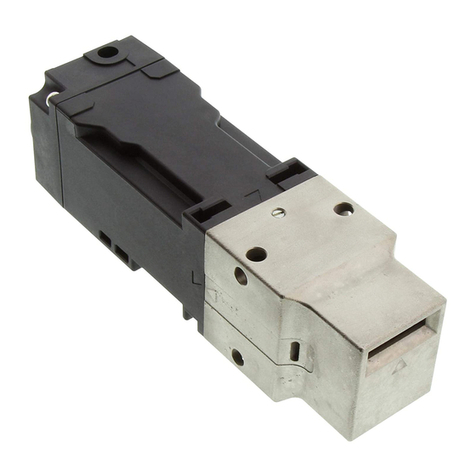
IDEC
IDEC HS1T Series User manual

IDEC
IDEC HS5E Series User manual
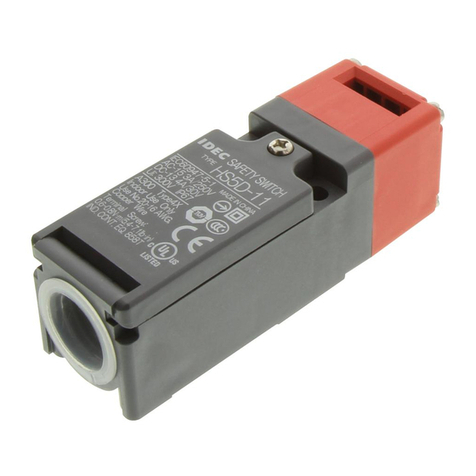
IDEC
IDEC HS5D-11 User manual
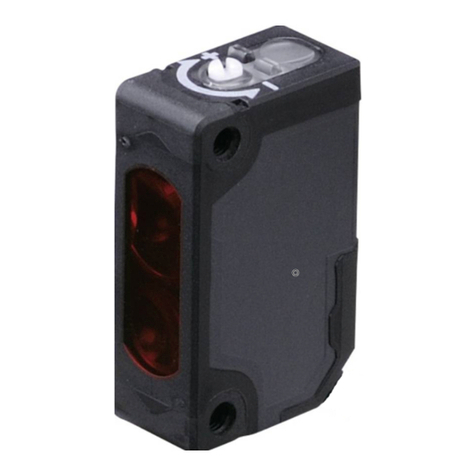
IDEC
IDEC SA1E Series User manual

IDEC
IDEC SX5E Series User manual

IDEC
IDEC HS5E Series User manual

IDEC
IDEC SA1E Series User manual

